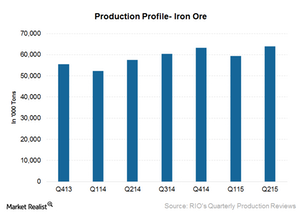Why Rio Tinto May Not Pull Back Its Iron Ore Volume Growth
Iron ore volumes are key to Rio Tinto’s (RIO) iron ore segment’s revenue. The other factor, seaborne iron ore prices, is determined by demand and supply dynamics.
Sept. 27 2015, Updated 5:06 a.m. ET

Iron ore volumes
Iron ore volumes are key to Rio Tinto’s (RIO) iron ore segment’s revenue. The other factor, seaborne iron ore prices, is determined by demand and supply dynamics, which are currently leading to pressure on prices. In this scenario, it’s big iron ore miners’ stated strategy to increase their volumes in order to reduce the pressure on revenues, cash flows, and ultimately bottom lines. In this article, we’ll see how RIO’s volumes are progressing in iron ore.
Volume growth despite unseasonal factors
- RIO’s production for 1H15 increased by 12% year-over-year (or YoY) to 123.3 million tons. This is despite the unseasonal weather conditions affecting 1H15 performance.
- Heavy inland rains reduced truck utilization, resulting in lost production at the mines.
- Production at Pilbara, Rio’s main iron ore producing asset, was 10% higher YoY due to ramping up to 290 million tons per year in May 2014.
- The Iron Ore Company of Canada achieved its best first half production of 8 million tons, a 14% increase YoY. The improved performance was mainly due to asset reliability and performance.
Forward expectations
- Since 1H15 shipments reduced by 7 million tons due to weather disruptions, RIO expects 2015 shipments to reach 340 million tons (on a 100% basis), weighted more towards the second-half.
- Low-cost brownfield developments have helped the company achieve debottlenecking and productivity improvements, which should contribute towards full capacity utilization of 360 million tons per year (or Mtpa) over time.
- RIO also expects an investment decision on the Silvergrass mine in 2016. It’s a 20-million-ton project in Pilbara.
- On being asked about pulling back on growth from iron ore, given low prices, RIO management commented that they have healthy margins even at current iron ore prices and that they won’t pull back on capacity (until 360 Mtpa) so that some other miner can bring capacity back online.
- Management also said that it believed that Chinese crude steel production will reach around 1 billion tons by 2030. This is almost in line with BHP Billiton’s (BHP)(BBL) latest view of a peak production of 935 million to 985 million tons in the mid-2020s.
The company also said that iron ore is in a relatively balanced position, as 120 million tons of capacity should exit this year with 45 million tons still at risk compared to 100 million tons of new seaborne iron ore capacity coming online.
BHP’s management believes iron ore prices will remain subdued and high-cost operations will remain curtailed.
Vale SA (VALE) has already announced a curtailment of 30 million tons of higher-cost iron ore production. Cliffs Natural Resources (CLF), on the other hand, is experiencing lower iron ore shipments due to lower export volumes and lower demand by steelmakers in the United States (SPY).
Rio is doing well on the iron ore volumes front. But in the next part of this series, we’ll see how it’s progressing on the cost front in order to weather the current weak iron ore price environment.
